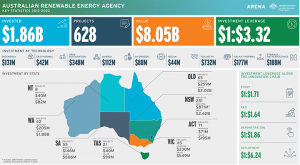The Federal Government has released proposed changes to the Safeguard Mechanism. The Government expects the reforms will cut Australia’s greenhouse gas emissions by a total of 205 million tonnes by the end of the decade.
That would be the equivalent of cutting total emissions from all Australia’s cars by two-thirds by 2030.
A consultation process on the approach to reforming the Safeguard Mechanism is now open until 24 February 2023. You can access a “Have Your Say” webpage.
The Government has set an overall 43 per cent emissions reduction target below the 2005 level by 2030, and net-zero by 2050.
The Safeguard Mechanism, introduced by the previous Government, currently applies to Australian industrial facilities that emit more than 100,000 tonnes of greenhouse gases annually.
It applies to more than 200 facilities, which must keep their emissions below a set baseline level of net emissions.
The changes are necessary, the Government says, because the current Safeguard Mechanism has been ineffective at driving emissions reduction. The Government says industry, business and experts have been calling for reform.
What is changing?
While the proposed reforms retain the baseline framework, changes include:
- Reducing baselines by 4.9 per cent, each year.
- Facilities will be able to earn “credits” if their emissions are below their baseline.
- Facilities failing to meet their baseline obligations will need to buy either credits from low emitters, or Australian Carbon Credit Units (ACCUs) from the Government. If facilities fail to meet emission reduction targets and don’t purchase offsets, they will be fined $275 per tonne.
- The price of one ACCU, representing one tonne of CO2-equivalent emissions will be capped at $75. That figure will rise in line with annual inflation plus 2 per cent year-on-year. ACCU’s spot price has peaked at more than $55 over 2022.
- Set baselines for new facilities under the mechanism at international best practice, adapted for an Australian context.
How is ARENA funding industrial decarbonisation?

Industrial decarbonisation has been a focus for ARENA in recent years.
The Agency has provided more than $110 million to projects at 20 existing facilities captured by the Safeguard Mechanism. Facilities include fertiliser plants, alumina refineries, smelters, steelworks and mines.
In October 2022, ARENA provided funding for a front-end engineering and design (FEED) study to develop a 500 MW hydrogen electrolyser to decarbonise the existing Gibson Island ammonia plant owned by Incitec outside of Brisbane.
ARENA has also supported projects with Alcoa and Rio to switch to electric and hydrogen calcination in alumina refining.
In June 2022, a report by the Australian Energy Transition Initiative, funded by ARENA, outlined opportunities to cut industrial emissions by 88 per cent and create hundreds of thousands of jobs in key industrial hubs like Gladstone.
ARENA is currently supporting projects aiming to decarbonise industrial processes.
For instance, reducing emissions from metals production is a strategic priority, with a focus on steel and aluminium value chains. As well as supporting individual projects, ARENA helps fund major reports such as A Roadmap for Decarbonising Australian Alumina Refining, published in November 2022.
Beyond facilities captured by the Safeguard Mechanism, ARENA also currently offers up to $43 million funding under the Industrial Energy Transformation Studies Program. The program supports feasibility and engineering studies to reduce emissions and lower energy costs for facilities in mining, manufacturing, gas supply, water, waste management, agriculture, and data centres.







By submitting this form you agree to pv magazine using your data for the purposes of publishing your comment.
Your personal data will only be disclosed or otherwise transmitted to third parties for the purposes of spam filtering or if this is necessary for technical maintenance of the website. Any other transfer to third parties will not take place unless this is justified on the basis of applicable data protection regulations or if pv magazine is legally obliged to do so.
You may revoke this consent at any time with effect for the future, in which case your personal data will be deleted immediately. Otherwise, your data will be deleted if pv magazine has processed your request or the purpose of data storage is fulfilled.
Further information on data privacy can be found in our Data Protection Policy.